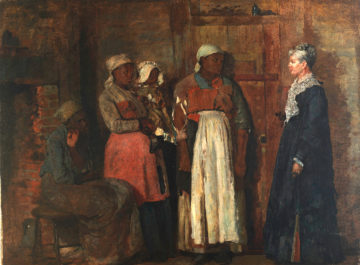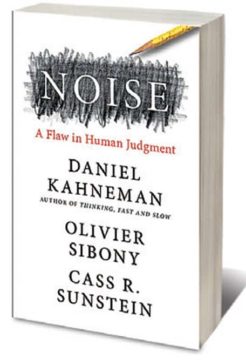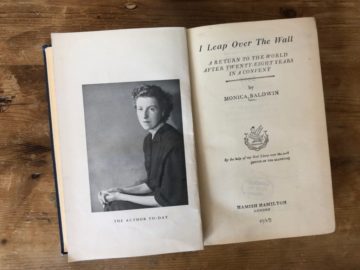Jordana Cepelewicz in Quanta:
 For more than 250 years, mathematicians have been trying to “blow up” some of the most important equations in physics: those that describe how fluids flow. If they succeed, then they will have discovered a scenario in which those equations break down — a vortex that spins infinitely fast, perhaps, or a current that abruptly stops and starts, or a particle that whips past its neighbors infinitely quickly. Beyond that point of blowup — the “singularity” — the equations will no longer have solutions. They will fail to describe even an idealized version of the world we live in, and mathematicians will have reason to wonder just how universally dependable they are as models of fluid behavior.
For more than 250 years, mathematicians have been trying to “blow up” some of the most important equations in physics: those that describe how fluids flow. If they succeed, then they will have discovered a scenario in which those equations break down — a vortex that spins infinitely fast, perhaps, or a current that abruptly stops and starts, or a particle that whips past its neighbors infinitely quickly. Beyond that point of blowup — the “singularity” — the equations will no longer have solutions. They will fail to describe even an idealized version of the world we live in, and mathematicians will have reason to wonder just how universally dependable they are as models of fluid behavior.
But singularities can be as slippery as the fluids they’re meant to describe. To find one, mathematicians often take the equations that govern fluid flow, feed them into a computer, and run digital simulations. They start with a set of initial conditions, then watch until the value of some quantity — velocity, say, or vorticity (a measure of rotation) — begins to grow wildly, seemingly on track to blow up.
Yet computers can’t definitively spot a singularity, for the simple reason that they cannot work with infinite values.
More here.

 The story of Babel is the best metaphor I have found for what happened to America in the 2010s, and for the fractured country we now inhabit. Something went terribly wrong, very suddenly. We are disoriented, unable to speak the same language or recognize the same truth. We are cut off from one another and from the past.
The story of Babel is the best metaphor I have found for what happened to America in the 2010s, and for the fractured country we now inhabit. Something went terribly wrong, very suddenly. We are disoriented, unable to speak the same language or recognize the same truth. We are cut off from one another and from the past. FEW FACES TO MEET the public spotlight in recent years have more to tell about the mental mechanisms of male shame, impunity, and self-absolution than that of the furry brown-and-white-spotted Spanish pointer staring out of Titian’s Diana and Callisto, 1556–59. This dog has been a bad dog, as he seems to know. (I say “he” since, according to the visual logic of gender organizing the suite of pictures of which Diana and Callisto forms one-sixth, Titian’s “big dog” simply can’t be a bitch.)1 Sometime previously, on a hunting trip that took an unexpected twist, this Spanish pointer turned against and devoured his master, Actaeon, a human hunter whom Diana, goddess of chastity, transformed into a stag after he came upon her bathing naked. Diana and Callisto asks its viewer to contemplate the aftermath of that attack; his master having passed through his digestive system, Actaeon’s dog, portrayed in another of the series’ pictures, reappears as a tagalong—or the captive?—of Diana’s band of proto-feminist separatists. Titian gives us the gaze of this pointer at the moment Diana is exiling Callisto, a favorite nymph who broke—unwillingly—her vow of virginity.
FEW FACES TO MEET the public spotlight in recent years have more to tell about the mental mechanisms of male shame, impunity, and self-absolution than that of the furry brown-and-white-spotted Spanish pointer staring out of Titian’s Diana and Callisto, 1556–59. This dog has been a bad dog, as he seems to know. (I say “he” since, according to the visual logic of gender organizing the suite of pictures of which Diana and Callisto forms one-sixth, Titian’s “big dog” simply can’t be a bitch.)1 Sometime previously, on a hunting trip that took an unexpected twist, this Spanish pointer turned against and devoured his master, Actaeon, a human hunter whom Diana, goddess of chastity, transformed into a stag after he came upon her bathing naked. Diana and Callisto asks its viewer to contemplate the aftermath of that attack; his master having passed through his digestive system, Actaeon’s dog, portrayed in another of the series’ pictures, reappears as a tagalong—or the captive?—of Diana’s band of proto-feminist separatists. Titian gives us the gaze of this pointer at the moment Diana is exiling Callisto, a favorite nymph who broke—unwillingly—her vow of virginity. The linchpin of the Met’s show, “The Gulf Stream” intensifies the artist’s racial focus even as it universalizes its sailor’s plight. A single Black man, the drama’s protagonist, is shown bare-chested and casually majestic—“modelled with a musculature and physical power,” Alain Locke wrote in 1936, that “broke the cotton-patch and back-porch tradition” and “began the artistic emancipation of the Negro subject.” But his innate power is to no avail. He lies across the deck of a devastated boat, as gape-mouthed sharks close in; the water nearby is flecked with blood. A few stalks of sugarcane coil across the deck, either a plain fact of his cargo or a sign of centuries of slave trade. “I regret very much that I have painted a picture that requires any description,” Homer replied with typical asperity to questions about its meaning. He also mentioned, though, the influence of Turner’s painting “Slave Ship” (originally titled “Slavers Throwing Overboard the Dead and Dying—Typhoon Coming On”), which Ruskin had once owned but said he found too painful to keep.
The linchpin of the Met’s show, “The Gulf Stream” intensifies the artist’s racial focus even as it universalizes its sailor’s plight. A single Black man, the drama’s protagonist, is shown bare-chested and casually majestic—“modelled with a musculature and physical power,” Alain Locke wrote in 1936, that “broke the cotton-patch and back-porch tradition” and “began the artistic emancipation of the Negro subject.” But his innate power is to no avail. He lies across the deck of a devastated boat, as gape-mouthed sharks close in; the water nearby is flecked with blood. A few stalks of sugarcane coil across the deck, either a plain fact of his cargo or a sign of centuries of slave trade. “I regret very much that I have painted a picture that requires any description,” Homer replied with typical asperity to questions about its meaning. He also mentioned, though, the influence of Turner’s painting “Slave Ship” (originally titled “Slavers Throwing Overboard the Dead and Dying—Typhoon Coming On”), which Ruskin had once owned but said he found too painful to keep. I’m dreaming of a book. It has the lightly worn wit of a Nora Ephron column combined with the empathy of Esther Perel. It combines the savage contrarianism of Rachel Cusk’s Aftermath with the virtuoso noticing of Joan Didion, the force of numbers that powered Caroline Criado Perez’s Invisible Women and the historical sweep of a Thomas Piketty treatise.
I’m dreaming of a book. It has the lightly worn wit of a Nora Ephron column combined with the empathy of Esther Perel. It combines the savage contrarianism of Rachel Cusk’s Aftermath with the virtuoso noticing of Joan Didion, the force of numbers that powered Caroline Criado Perez’s Invisible Women and the historical sweep of a Thomas Piketty treatise. T
T Are crowds smart or dumb? You may have heard the terms “wisdom of the crowds” and the “madness of crowds.” The former idea is that the collective opinion of a group of people is often more accurate than any individual person, and that gathering input from many individuals averages out the errors of each person and produces a more accurate answer. In contrast, the “madness of crowds” captures the idea that, relative to a single individual, large numbers of people are more likely to indulge their passions and get carried away by impulsive or destructive behaviors. So, which concept more accurately reflects reality?
Are crowds smart or dumb? You may have heard the terms “wisdom of the crowds” and the “madness of crowds.” The former idea is that the collective opinion of a group of people is often more accurate than any individual person, and that gathering input from many individuals averages out the errors of each person and produces a more accurate answer. In contrast, the “madness of crowds” captures the idea that, relative to a single individual, large numbers of people are more likely to indulge their passions and get carried away by impulsive or destructive behaviors. So, which concept more accurately reflects reality? Last month, while most of the world focused on the war in Ukraine and worried that a beleaguered Russian leadership might resort to nuclear weapons, thus escalating the conflict into a direct war with the U.S.-led NATO nuclear-armed alliance, a nearly tragic accident involving India and Pakistan pointed to another path to nuclear war. The accident highlighted how complex technological systems, including those involving nuclear weapons, can generate unexpected routes to potential disaster—especially when managed by overconfident organizations.
Last month, while most of the world focused on the war in Ukraine and worried that a beleaguered Russian leadership might resort to nuclear weapons, thus escalating the conflict into a direct war with the U.S.-led NATO nuclear-armed alliance, a nearly tragic accident involving India and Pakistan pointed to another path to nuclear war. The accident highlighted how complex technological systems, including those involving nuclear weapons, can generate unexpected routes to potential disaster—especially when managed by overconfident organizations. As a quick stroll on social media reveals, most people love showing that they are good. Whether by expressing compassion for disaster victims, sharing a post to support a social movement, or denouncing a celebrity’s racist comment, many people are eager to broadcast their high moral standing.
As a quick stroll on social media reveals, most people love showing that they are good. Whether by expressing compassion for disaster victims, sharing a post to support a social movement, or denouncing a celebrity’s racist comment, many people are eager to broadcast their high moral standing. One way to read this unwieldy book, with its sixty-two-page bibliography, is as a grand tour of societies from prehistory to the eighteenth century once classed by anthropologists as “primitive” according to the evolutionary model that Dawn blows to smithereens. The Kwakiutl peoples of the Northwest Coast practiced chattel slavery; their neighbors to the south in what is now California, the Yurok, did not. At Göbekli Tepe in modern Turkey, foragers erected intricately carved megaliths six thousand years before Stonehenge. The Natchez Great Sun wielded absolute power over his subjects but rarely left the Great Village, so most Natchez just stayed out of his reach. The Kwakiutl were aristocratic during winter but splintered into clan formations for the summer fishing season. Cheyenne and Lakota appointed an authoritarian police force to keep order during the buffalo hunt then dispersed into small, “anarchic” bands. The ancient Mesoamerican Olmec of present-day Mexico appear to have organized their society in part around ball games, erecting colossal stone heads depicting helmeted champions. And Chavín de Huántar in northern Peru in the first millennium BCE, with its sophisticated cut-stone architecture and monumental sculpture—well, if the authors are to be believed, it was a gigantic memory palace, a storehouse for imagistic records of shamanic journeys and hallucinogenic visions.
One way to read this unwieldy book, with its sixty-two-page bibliography, is as a grand tour of societies from prehistory to the eighteenth century once classed by anthropologists as “primitive” according to the evolutionary model that Dawn blows to smithereens. The Kwakiutl peoples of the Northwest Coast practiced chattel slavery; their neighbors to the south in what is now California, the Yurok, did not. At Göbekli Tepe in modern Turkey, foragers erected intricately carved megaliths six thousand years before Stonehenge. The Natchez Great Sun wielded absolute power over his subjects but rarely left the Great Village, so most Natchez just stayed out of his reach. The Kwakiutl were aristocratic during winter but splintered into clan formations for the summer fishing season. Cheyenne and Lakota appointed an authoritarian police force to keep order during the buffalo hunt then dispersed into small, “anarchic” bands. The ancient Mesoamerican Olmec of present-day Mexico appear to have organized their society in part around ball games, erecting colossal stone heads depicting helmeted champions. And Chavín de Huántar in northern Peru in the first millennium BCE, with its sophisticated cut-stone architecture and monumental sculpture—well, if the authors are to be believed, it was a gigantic memory palace, a storehouse for imagistic records of shamanic journeys and hallucinogenic visions. Ten years after Monica Baldwin voluntarily entered an enclosed religious order of Augustinian nuns, she began to think she might have made a mistake. She had entered the order on October 26, 1914, shortly after the outbreak of the World War I, when she was just twenty-one years old. At thirty-one, she hadn’t lost her faith, but she had begun to doubt her vocation; the sacrifices that cloistered life entailed did not come easily to her, and unlike many around her, she hadn’t experienced a “vital encounter” between her soul and God. Eighteen years later, she finally knew for sure: it was time to leave. Granted special dispensation from the Vatican to leave the order but remain a Roman Catholic, Baldwin—who was now forty-nine years old—quit the only adult life she’d known, that of the “strictest possible enclosure,” and emerged back into the world in 1941, into a world that had just plunged, once again, into war.
Ten years after Monica Baldwin voluntarily entered an enclosed religious order of Augustinian nuns, she began to think she might have made a mistake. She had entered the order on October 26, 1914, shortly after the outbreak of the World War I, when she was just twenty-one years old. At thirty-one, she hadn’t lost her faith, but she had begun to doubt her vocation; the sacrifices that cloistered life entailed did not come easily to her, and unlike many around her, she hadn’t experienced a “vital encounter” between her soul and God. Eighteen years later, she finally knew for sure: it was time to leave. Granted special dispensation from the Vatican to leave the order but remain a Roman Catholic, Baldwin—who was now forty-nine years old—quit the only adult life she’d known, that of the “strictest possible enclosure,” and emerged back into the world in 1941, into a world that had just plunged, once again, into war. W
W Cancer drugs usually take a scattergun approach. Chemotherapies inevitably hit healthy bystander cells while blasting tumours, sparking a slew of side effects. It is also a big ask for an anticancer drug to find and destroy an entire tumour — some are difficult to reach, or hard to penetrate once located. A long-dreamed-of alternative is to inject a battalion of tiny robots into a person with cancer. These miniature machines could navigate directly to a tumour and smartly deploy a therapeutic payload right where it is needed. “It is very difficult for drugs to penetrate through biological barriers, such as the blood–brain barrier or mucus of the gut, but a microrobot can do that,” says Wei Gao, a medical engineer at the California Institute of Technology in Pasadena.
Cancer drugs usually take a scattergun approach. Chemotherapies inevitably hit healthy bystander cells while blasting tumours, sparking a slew of side effects. It is also a big ask for an anticancer drug to find and destroy an entire tumour — some are difficult to reach, or hard to penetrate once located. A long-dreamed-of alternative is to inject a battalion of tiny robots into a person with cancer. These miniature machines could navigate directly to a tumour and smartly deploy a therapeutic payload right where it is needed. “It is very difficult for drugs to penetrate through biological barriers, such as the blood–brain barrier or mucus of the gut, but a microrobot can do that,” says Wei Gao, a medical engineer at the California Institute of Technology in Pasadena. I have been doing a great deal of publicity these past weeks for my new book,
I have been doing a great deal of publicity these past weeks for my new book,